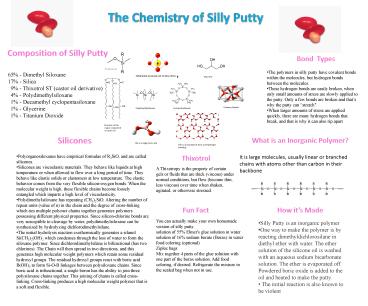The Chemistry of Silly Putty PowerPoint PPT Presentation
Title: The Chemistry of Silly Putty
1
The Chemistry of Silly Putty
Composition of Silly Putty
Bond Types
Tetrahedral structural unit of silica (SiO2),
The siloxane unit
- The polymers in silly putty have covalent bonds
within the molecules, but hydrogen bonds between
the molecules. - These hydrogen bonds are easily broken, when only
small amounts of stress are slowly applied to the
putty. Only a few bonds are broken and thats why
the putty can stretch". - When larger amounts of stress are applied
quickly, there are many hydrogen bonds that
break, and that is why it can also rip apart
65 - Dimethyl Siloxane 17 - Silica 9 -
Thixotrol ST (castor oil derivative) 4 -
Polydimethylsiloxane 1 - Decamethyl
cyclopentasiloxane 1 - Glycerine 1 -
Titanium Dioxide
Glycerine
Titanium Dioxide
Polydimethylsiloxane
Cyclopentasiloxane
Structure of the major component of caster oil
Silicones
What is an Inorganic Polymer?
This is a single boric acid
- Polyorganosiloxanes have empirical formulas of
R2SiO, and are called silicones. - Silicones are viscoelastic materials. They behave
like liquids at high temperature or when allowed
to flow over a long period of time. They behave
like elastic solids or elastomers at low
temperature. The elastic behavior comes from the
very flexible silicon-oxygen bonds. When the
molecular weight is high, these flexible chains
become loosely entangled which imparts a high
level of viscoelasticity. - Polydimethylsiloxane has repeating (CH3)2SiO.
Altering the number of repeat units (value of n)
in the chain and the degree of cross-linking
which ties multiple polymer chains together
generates polymers possessing different physical
properties. Since silicon-chlorine bonds are very
susceptible to cleavage by water,
polydimethylsiloxane can be synthesized by
hydrolyzing dichlorodimethylsilane. - The initial hydrolysis reaction exothermically
generates a silanol Si(CH3)2(OH)2 which condenses
through the loss of water to form the siloxane
polymer. Since dichlorodimethylsilane is
bifunctional (has two chlorines). The Chain will
then spread in two directions, and this generates
high molecular weight polymers which retain some
residual hydroxyl groups. The residual hydroxyl
groups react with boric acid B(OH)3 to form
Si-O-B linkages between polysiloxane chains.
Since boric acid is trifunctional, a single boron
has the ability to join three polysiloxane chains
together. This joining of chains is called
cross-linking. Cross-linking produces a high
molecular weight polymer that is a soft and
flexible.
This is an example of boric acid hydrogen bonding.
It is large molecules, usually linear or branched
chains with atoms other than carbon in their
backbone
Thixotrol
A Thixotropy is the property of certain gels or
fluids that are thick (viscous) under normal
conditions, but flow (become thin, less viscous)
over time when shaken, agitated, or otherwise
stressed.
How its Made
Fun Fact
You can actually make your own homemade version
of silly putty. solution of 55 Elmer's glue
solution in water solution of 16 sodium borate
(Borax) in water food coloring (optional)
Ziploc bags Mix together 4 parts of the glue
solution with one part of the borax solution. Add
food coloring, if desired. Refrigerate the
mixture in the sealed bag when not in use.
- Silly Putty is an inorganic polymer
- One way to make the polymer is by reacting
dimethyldichlorosilane in diethyl ether with
water. The ether solution of the silicone oil is
washed with an aqueous sodium bicarbonate
solution. The ether is evaporated off. Powdered
boric oxide is added to the oil and heated to
make the putty. - The initial reaction is also known to be violent

